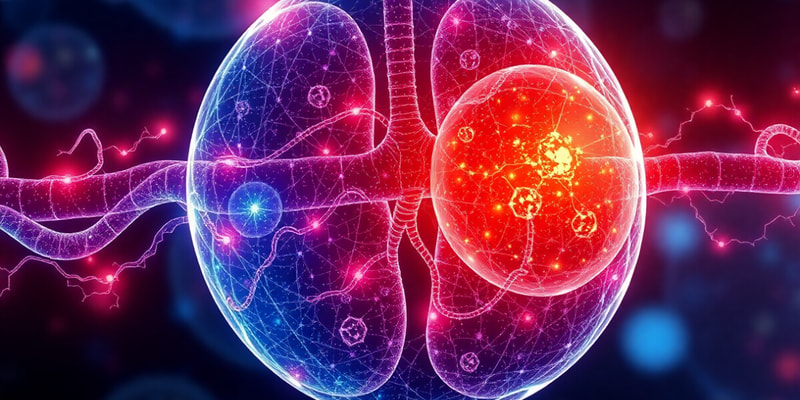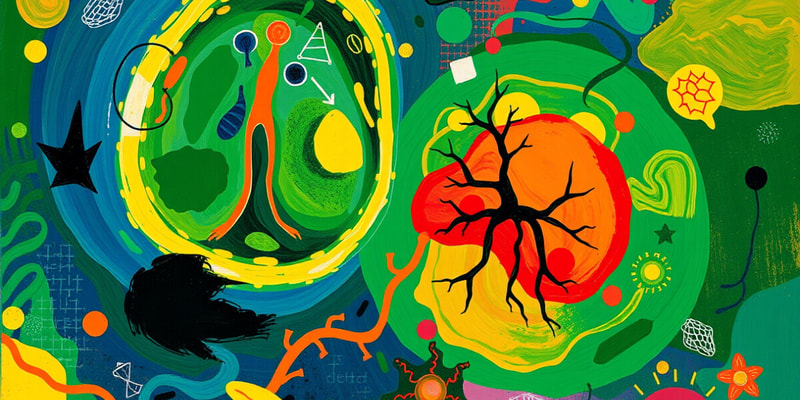Podcast Beta
Questions and Answers
What is the end product of alcohol fermentation?
Which organisms primarily utilize lactic acid fermentation?
What is the ATP yield from pyruvate oxidation?
During glycolysis, how many ATP molecules are consumed initially?
Signup and view all the answers
How many NADH molecules are generated in the citric acid cycle per glucose molecule?
Signup and view all the answers
Which stage of cellular respiration generates the majority of ATP?
Signup and view all the answers
What is the net ATP gain from glycolysis?
Signup and view all the answers
In lactic acid fermentation, what substance is primarily produced?
Signup and view all the answers
What is one of the main products generated during pyruvate oxidation?
Signup and view all the answers
How many molecules of CO2 are produced from the oxidation of one glucose molecule?
Signup and view all the answers
Which statement correctly describes the role of NADH produced during pyruvate oxidation?
Signup and view all the answers
What is the name of the cycle that pyruvate oxidation connects to for further oxidation of Acetyl-CoA?
Signup and view all the answers
In which part of the cell does the citric acid cycle take place?
Signup and view all the answers
Which molecule is NOT a product of the citric acid cycle from one glucose molecule?
Signup and view all the answers
How is energy generated during the citric acid cycle?
Signup and view all the answers
For each glucose molecule entering the citric acid cycle, how many NADH molecules are produced?
Signup and view all the answers
What is the role of NADH and FADH2 in the electron transport chain?
Signup and view all the answers
Which of the following correctly summarizes the total ATP yield from one glucose molecule through the entire process?
Signup and view all the answers
What primarily powers ATP synthase during the ATP synthesis process?
Signup and view all the answers
Why might the theoretical maximum yield of ATP per glucose molecule differ between eukaryotes and bacteria?
Signup and view all the answers
What is a key function of the electron transport chain?
Signup and view all the answers
How many ATP are produced during glycolysis?
Signup and view all the answers
Which process is NOT a source of direct ATP production during glucose oxidation?
Signup and view all the answers
What is one reason for the variations in actual ATP yields during the complete oxidation of glucose?
Signup and view all the answers
What is the primary function of ATP synthase in cellular respiration?
Signup and view all the answers
In which condition is NAD+ primarily regenerated through oxidative phosphorylation?
Signup and view all the answers
Which pathways are involved in regenerating NAD+ in the absence of oxygen?
Signup and view all the answers
What role does the electron transport chain (ETC) play in cellular respiration?
Signup and view all the answers
Which complex in the electron transport chain does NADH transfer its electrons to?
Signup and view all the answers
What characterizes the flow of electrons through the electron transport chain?
Signup and view all the answers
How does the regeneration of NAD+ support glycolysis?
Signup and view all the answers
What is the process through which ATP is synthesized in the electron transport chain?
Signup and view all the answers
What is the primary role of ATP synthase in cellular respiration?
Signup and view all the answers
How many ATP are directly produced during glycolysis?
Signup and view all the answers
What process primarily accounts for the majority of ATP generated during glucose oxidation?
Signup and view all the answers
What is one factor that can reduce the efficiency of ATP production?
Signup and view all the answers
What is the estimated theoretical maximum yield of ATP per glucose molecule in bacteria?
Signup and view all the answers
Which cycle produces the most electron carriers like NADH and FADH2?
Signup and view all the answers
What happens to protons (H+) as electrons are passed down the electron carriers?
Signup and view all the answers
What is one reason the actual ATP yield can vary when glucose is oxidized?
Signup and view all the answers
Study Notes
NAD+ in Cellular Respiration
- NAD+ is crucial for cellular respiration.
- NAD+ captures energy from glucose breakdown.
- NADH delivers energy to the Electron Transport Chain for ATP production.
- NAD+ regenerates from NADH through oxidative phosphorylation (aerobic) or fermentation (anaerobic).
Electron Transport Chain
- The ETC is the final stage of aerobic respiration, responsible for most ATP production.
- Located in the inner mitochondrial membrane.
- ETC consists of protein complexes and electron carriers.
- Creates a proton gradient for ATP synthesis through chemiosmosis.
- NADH and FADH2 deliver electrons to the ETC.
- NADH enters at Complex I, FADH2 enters at Complex II.
- Electron flow through the ETC releases energy.
Pyruvate Oxidation
- Converts pyruvate (from glycolysis) into Acetyl-CoA.
- Produces CO2, a waste product of cellular respiration.
- Produces NADH, which carries electrons to the ETC for ATP synthesis.
- Links glycolysis to the Citric Acid Cycle by transforming pyruvate into a form that can enter the cycle.
Citric Acid Cycle
- Also known as the Krebs Cycle or TCA cycle.
- Occurs in the mitochondrial matrix.
- Completely oxidizes Acetyl-CoA, producing:
- 2 ATP molecules (substrate-level phosphorylation)
- 4 CO2 molecules, representing complete glucose oxidation.
- 6 NADH molecules.
- 2 FADH2 molecules.
Fermentation
- Anaerobic process that regenerates NAD+ from NADH.
- Allows glycolysis to continue producing limited ATP.
- Two main types:
- Lactic Acid Fermentation: produces lactate (lactic acid)
- Alcohol Fermentation: produces ethanol and CO2
ATP Accounting
- ATP yield varies significantly depending on the metabolic efficiency of the cell.
- Estimated theoretical maximum yield is 38 ATP per glucose.
- Actual yield in eukaryotes typically ranges from 30-36 ATP.
- Factors influencing ATP yield:
- The efficiency of NADH transport into mitochondria.
- The leakiness of the inner mitochondrial membrane.
- Use of proton gradient for other processes.
ATP Synthase
- A protein complex embedded in the inner mitochondrial membrane.
- Responsible for ATP synthesis during chemiosmosis.
- Driven by the proton gradient established by the ETC.
- The movement of protons through ATP synthase powers ATP synthesis.
Studying That Suits You
Use AI to generate personalized quizzes and flashcards to suit your learning preferences.
Related Documents
Description
This quiz covers the essential roles of NAD+ in cellular respiration, particularly its functions in energy capture and transfer during electron transport. It discusses pyruvate oxidation and the final stages of aerobic respiration, highlighting the importance of ATP production. Test your knowledge on these critical biochemical processes!




